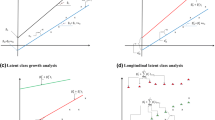Abstract
In this paper, we propose an extension to the first-order branching process with immigration in the presence of fixed covariates and unobservable random effects. The extension permits the possibility that individuals from the second generation of the process may contribute to the total number of offsprings at time \(t\) by producing offsprings of their own. We will study the basic properties of the second order process and discuss a generalized quasilikelihood (GQL) estimation of the mean and variance parameters and the generalized method of moments estimation of the correlation parameters. We will discuss the asymptotic distribution of the GQL estimator by first deriving the influence curve of the estimator. For the fixed effects model we shall derive a forecasting function and the variance of the forecast error. The performance of the proposed estimators and forecasts will be examined through a simulation study.


Similar content being viewed by others
References
Al-Osh MA, Alzaid AA (1987) First order integer-valued autoregressive (INAR) process. J Time Ser Anal 8(3):261–275
Angelov AG, Slavtchova-Bojkova M (2012) Bayesian estimation of the offspring mean in branching processes: application to infectious disease data. Comput Math Appl 64:229–235
Artalejo JR, Economou A, Lopez-Herrero MJ (2010) The maximum number of infected individuals in SIS epidemic models: computational techniques and quasi-stationary distributions. J Comput Appl Math 233:2563–2574
Allen LJS, Burgin AM (2000) Comparison of deterministic and stochastic SIS and SIR models in discrete time. Math Biosci 163:1–33
Britton T (2010) Stochastic epidemic models: a survey. Math Biosci 225:24–35
Hampel FR, Ronchetti EM, Rousseeuw PJ, Stahel WA (1986) Robust statistics. the approach based on influence functions. Wiley series in probability and mathematical statistics: probability and mathematical statistics. Wiley, New York
Heyde CC, Seneta E (1972) Estimation theory for growth and immigration rates in a multiplicative process. J Appl Probab 9:235–258
Kallenberg PJM (1979) Branching processes with continuous state space. Mathematical Centre Tracts, No. 117, Amsterdam
Kashikar AS, Deshmukh SR (2012) Second order branching process with continuous state space. Stat Probab Lett 82(11):1930–1934
Klimko LA, Nelson PI (1978) On conditional least squares estimation for stochastic processes. Ann Stat 6:629–642
Ma Z, Li J (2009) Dynamic modelling and analysis of epidemics. World Scientific, Singapore
McKenzie E (1988) ARMA models for dependent sequences of Poisson counts. Adv Appl Probab 20(4):822–835
Nelson PI (1980) A note on strong consistency of least squares estimators in regression models with martingale difference errors. Ann Stat 5:1057–1064
Oyet AJ, Sutradhar BC (2013) Longitudinal modelling of infectious disease. Sankhy\(\bar{a}\) B. doi:10.1007/s13571-012-0056-x
Sutradhar B (2003) An overview on regression models for discrete longitudinal responses. Stat Sci 18(3):377–393
Sutradhar B, Oyet AJ, Gadag VG (2010) On quasi-likelihood estimation for branching processes with immigration. Can J Stat 38(2):290–313
Wei CZ, Winnicki J (1990) Estimation of the mean in the branching process with immigration. Ann Stat 18:1757–1773
Winnicki J (1988) Estimation theory for the branching process with immigration. Contemp Math 80: 301–321
Acknowledgments
Many thanks to the referee and editor whose valuable suggestions have led to improvements in the quality of this paper. This research is partially supported by the Natural Sciences and Engineering Research Council of Canada.
Author information
Authors and Affiliations
Corresponding author
Rights and permissions
About this article
Cite this article
Zhang, C., Oyet, A.J. Second order longitudinal dynamic models with covariates: estimation and forecasting. Metrika 77, 837–859 (2014). https://doi.org/10.1007/s00184-013-0467-3
Received:
Published:
Issue Date:
DOI: https://doi.org/10.1007/s00184-013-0467-3




